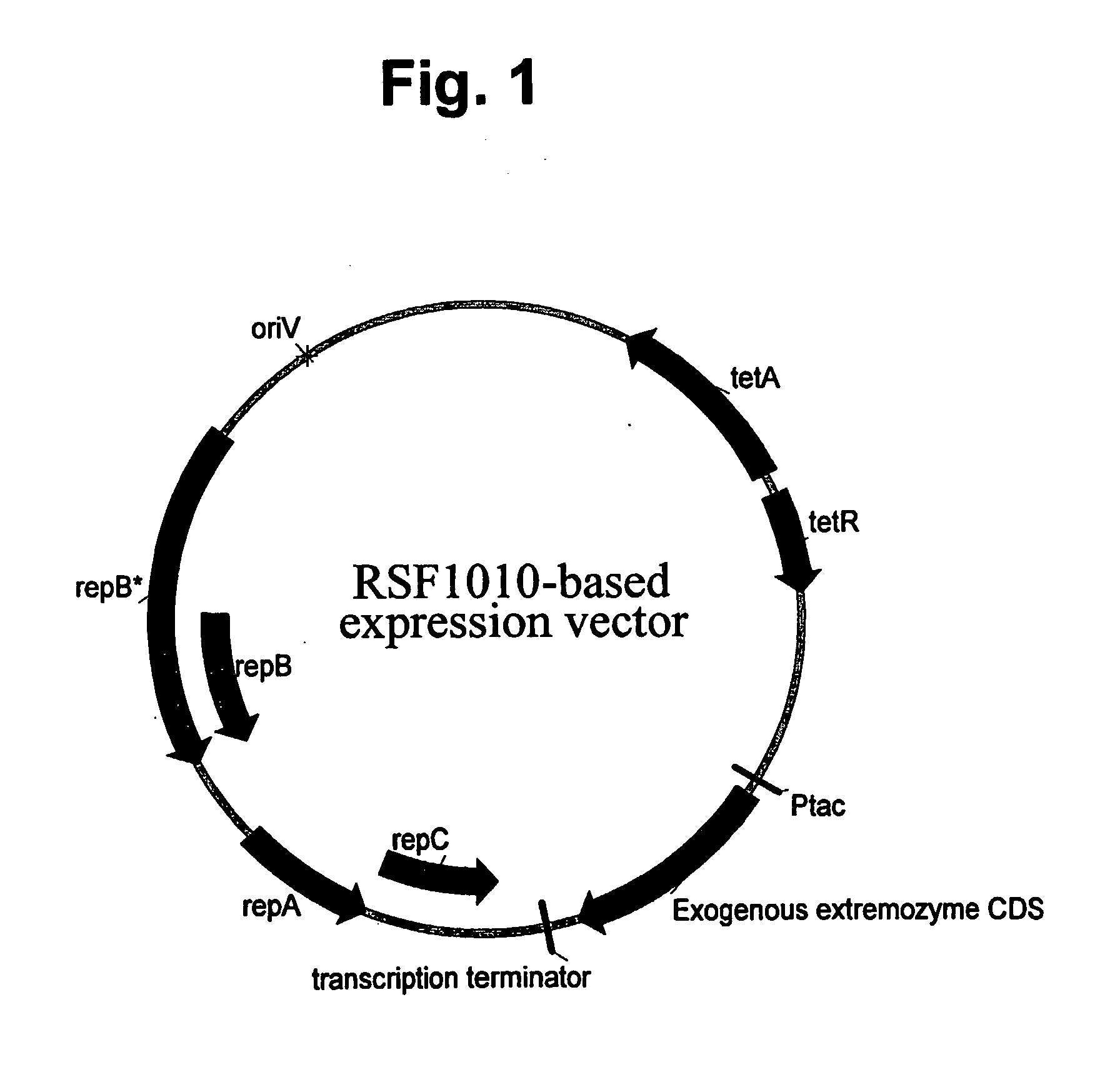Over-expression of extremozyme genes in pseudomonads and closely related bacteria
a technology of extremozyme and pseudomonads, applied in the field of overexpression of extremozyme genes in pseudomonads and closely related bacteria, can solve the problems of not being forthcoming, extremophiles have been found either impossible to culture, or at least too difficult to culture, unreliable at producing commercial quantities of extremozyme, etc., to achieve high cell density, high extremozyme expression, and high cell density
- Summary
- Abstract
- Description
- Claims
- Application Information
AI Technical Summary
Benefits of technology
Problems solved by technology
Method used
Image
Examples
example 1
Extremophilic Cellulase
Example 1A
Construction of Pseudomonas fluorescens Strains Expressing Thermotoga maritima and Pyrococcus furiosus Cellulases
Methods
[0134] Molecular Biology techniques were as described in Ausubel et al. (eds.), Current Protocols in Molecular Biology (1995) (John Wiley & Sons); Sambrook, Fritsch, & Maniatis (eds.), Molecular Cloning (1989) (Cold Spring Harbor Laboratory Press, NY).
Expression Cassettes
[0135] The parent plasmid pMYC1803 is a derivative of pTJS260 (see U.S. Pat. No. 5,169,760 to Wilcox), carrying a regulated tetracycline resistance marker and, the replication and mobilization loci from RSF1010 plasmid. (pMYC1803 is a source for many derivative plasmids useful in expression extremozymes according to the present invention. Most such derivatives differ from pMYC1803 primarily around the ORF in order to introduce convenient restriction sites for cloning different exogenous genes.).
[0136] The Thermotoga maritima cellulase gene (0.94 kb encoding...
example 1b
Expression of Extremophilic Cellulases
[0138] Seed cultures were produced as follows. P. fluorescens MB214 transformants were inoculated into 2-5 mL of Luria-Bertani Broth (“LB”), supplemented with 15 μg / mL tetracycline HCl, in 15 ml Falcon tubes and growth for 16-20 h, at 32° C., 300 rpm. 1 mL of the seed culture (in LB) was placed into 50 mL of the Terrific Broth (TB) medium (see Table 4), supplemented with 15 μg / mL tetracycline HCl, in 250 ml bottom baffled shake-flasks, and incubated for 5 h at 32° C., 300 rpm. Induction was performed by the addition of IPTG to a final concentration of 0.5 mM. Samples were taken at 16-24 hours post-induction.
TABLE 3TB Medium RecipeBacto tryptone12g / LBacto yeast extract24Glycerol10KH2PO4 2.3K2HPO412.5
[0139] Results for shake-flask scale results are presented in Table 5.
TABLE 5List of strains constructed and their performance in shake-flasksCellulase YieldExpressionby SDS-PAGECassetteStrainIsolates #(g / L)PT5MB214pMYC195150.6″180.6PtacMB214pMYC...
example 2
Extremophilic Amylases
[0142] Alpha-amylase genes from a Thermococcal and a Sulfolobus solfataricus source were PCR amplified and cloned onto pMYC1803 as in Example 1, so that they became operably linked to a control sequence including the Ptac promoter in, an RSF1010-based vector also carrying a tetracycline resistance marker, as shown in FIG. 1. The resulting constructs were transformed into LacI+ P. fluorescens MB101. The resulting recombinant host cells were cultured in 10 L fermentors by growth in a mineral salts medium (supplemented with tetracycline and fed with glucose or glycerol). The transformants were grown in fed-batch fermentation cultures, ultimately to cell densities providing biomasses within the range of about 20 g / L to more than 70 g / L (dry cell weight). The gratuitous inducer of the Ptac promoter, IPTG, was added to induce expression. Thereupon, the amylases were expressed (i.e. over-expressed) to a level within the range of about 5% tcp to more than 30% tcp. Thu...
PUM
| Property | Measurement | Unit |
|---|---|---|
| Density | aaaaa | aaaaa |
| Density | aaaaa | aaaaa |
| Density | aaaaa | aaaaa |
Abstract
Description
Claims
Application Information
 Login to View More
Login to View More - R&D
- Intellectual Property
- Life Sciences
- Materials
- Tech Scout
- Unparalleled Data Quality
- Higher Quality Content
- 60% Fewer Hallucinations
Browse by: Latest US Patents, China's latest patents, Technical Efficacy Thesaurus, Application Domain, Technology Topic, Popular Technical Reports.
© 2025 PatSnap. All rights reserved.Legal|Privacy policy|Modern Slavery Act Transparency Statement|Sitemap|About US| Contact US: help@patsnap.com

